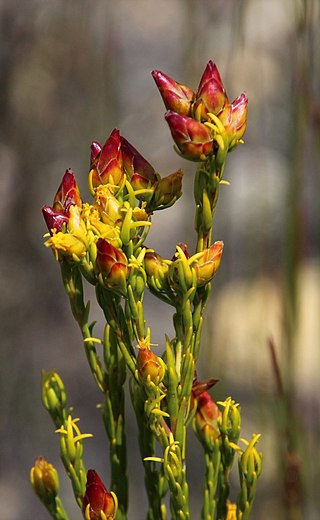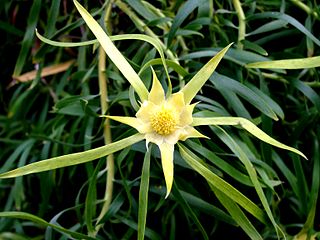
Leucadendron rourkei, the Uniondale conebush, is a flower-bearing shrub belonging to the genus Leucadendron and forms part of the fynbos. The plant is native to the Western Cape and Eastern Cape, South Africa. The plant is rare.

Leucadendron loeriense, the Loerie conebush, is a flower-bearing shrub that belongs to the genus Leucadendron and forms part of the fynbos. The plant is native to the Western Cape, where it is found in the Elandsberg, Baviaanskloof and Groot-Winterhoek mountains. The shrub grows 2.5 m tall and flowers in December and January.

Leucadendron olens, the yellow conebush, is a flower-bearing shrub that belongs to the genus Leucadendron and forms part of the fynbos. The plant is native to the Western Cape, South Africa.

Leucadendron rubrum, the spinning top, is a flower-bearing shrub belonging to the genus Leucadendron and forms part of the fynbos. The plant is native to the Western Cape, South Africa.

Leucadendron eucalyptifolium, the gum-leaved conebush, is a flower-bearing shrub belonging to the genus Leucadendron and forms part of the fynbos. The plant is native to the Western Cape and the Eastern Cape, where it occurs in the Potberg, Riversdal Plains, Langeberg, Outeniqua Mountains, Tsitsikamma Mountains, Kouga Mountains, Elandsberg, Swartberg, Waboomsberg, Warmwaterberg, Touwsberg, Rooiberg and Soetwaterberg. The shrub grows 4 m tall and bears flowers from July to October.
Leucadendron loranthifolium, commonly known as the green-flower sunbush, is a flower-bearing shrub belonging to the genus Leucadendron and forms part of the fynbos. The plant is native to the Western Cape where it occurs in the Gifberg, Cederberg, Sandveld, and Hex River Mountains.

Aulax pallasia, the needle-leaf featherbush, is a species of shrub in the genus Aulax. It is native to the Western Cape, South Africa.

Aulax umbellata, the broad-leaf featherbush, is a shrub native to the Western Cape. It occurs on the lower slopes and coastal lowlands from Kogelberg to Mossel Bay up to altitudes of 500 m. The shrub grows with a single stem and grows up to 2.5 m tall. Umbellata means like an umbrella. The leaves have rounded tips and can become 110 mm long and 15 mm in diameter. The plant is bisexual, male and female flowers grow on different plants. The plants bloom from September to February. A variety of insect species help pollinate the plants. Female flowers dry out and form a woody shell in which the seeds are formed and preserved. Fires destroy the plant and only the seeds survive.

Serruria glomerata, the cluster spiderhead, is a flower-bearing shrub that belongs to the genus Serruria and forms part of the fynbos. The plant is native to the Western Cape, it occurs on the Cape Flats and Cape Peninsula. The shrub is erect and grows only 40 cm tall and bears flowers from August to October.
Paranomus candicans, the powder sceptre, is a flower-bearing shrub that belongs to the genus Paranomus and forms part of the fynbos. The plant is native to the Western Cape, South Africa.
Leucadendron gydoense, the Gydo conebush, is a flower-bearing shrub that belongs to the genus Leucadendron and forms part of the fynbos. The plant is native to the Western Cape, South Africa.
Paranomus lagopus, the rabbit-paw sceptre, is a flower-bearing shrub that belongs to the genus Paranomus and forms part of the fynbos. The plant is native to the Western Cape where it occurs in the Koue Bokkeveld Mountains, Groot-Winterhoek Mountains and Elandskloof Mountain.
Paranomus capitatus, the fine-leaf sceptre, is a flower-bearing shrub that belongs to the genus Paranomus and forms part of the fynbos. The plant is native to the Western Cape where it occurs in the Du Toits Mountains south of Du Toitskloof Pass to the northern slopes of the Riviersonderend Mountains.
Paranomus esterhuyseniae, the Kouga sceptre, is a flower-bearing shrub that belongs to the genus Paranomus and forms part of the fynbos. The plant is native to the Western Cape where it occurs in the Kouga Mountains and Outeniqua Mountains.
Diastella parilis, the Worcester silkypuff, is a flower-bearing shrub that belongs to the genus Diastella and forms part of the fynbos. The plant is native to the Western Cape and occurs in the Breede River Valley from the Elandskloof to the Slanghoek Mountains. The shrub is erect and grows 70 cm tall and bears flowers from July to January.

Diastella proteoides, the Flats silkypuff, is a flower-bearing shrub that belongs to the genus Diastella and forms part of the fynbos. The plant is native to the Western Cape and occurs on the Cape Flats from Tokai to Malmesbury and Eerste River. The shrub is flat and grows only 50 cm high but 3 m in diameter and flowers throughout the year with the peak from July to February.
Diastella thymelaeoides is a flower-bearing shrub that belongs to the genus Diastella and forms part of the fynbos. The plant is native to the Western Cape and occurs in the Hottentots Holland Mountains and northern Kogelberg around the Steenbras Dam. The shrub grows upright and grows only 1.5 m tall and flowers throughout the year with a peak from August to November.

Leucadendron elimense, the Elim conebush, is a flower-bearing shrub, which belongs to the genus Leucadendron and forms part of the fynbos. The plant is native to the Western Cape, South Africa.

Leucadendron levisanus, commonly known as the Cape flats conebush, is a flower-bearing shrub that belongs to the genus Leucadendron and forms part of the fynbos. The plant is native to the Western Cape, where it occurs in the Cape Flats from Vishoek to Eerste River and Mamre. The shrub grows 2 m tall and bears flowers in October.

Spatalla racemosa, the lax-stalked spoon, is a flower-bearing shrub that belongs to the genus Spatalla and forms part of the fynbos. The plant is native to the Western Cape of South Africa where it is found in the Kogelberg, Groenland mountains, Babilonstoringberge, Kleinrivier Mountains as well as at Villiersdorp.












